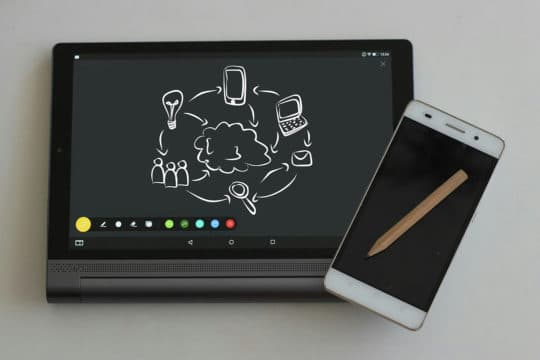The use of technology is vastly dynamic especially the way things are done currently, including the work in all academic institutions where the instruction and learning process needs a great deal of advancement. For a number of years now, many institutions of learning have invested heavily in establishing fast, reliable, and fast internet services in their schools. The services provided by the internet have had a major impact in the educational context, even in organizations, and especially in teaching and learning methods. The Internet has made it possible for students and teachers across the globe to be interconnected.
The internet is a fundamental subject area in the improvement of information technology. It has become a crucial instrument and a requirement of the knowledge-based society we have today as well as a vital means to present current and up-to-date information has become a form of effortless communication for everyone anywhere, and especially for research and learning. Students will find it beneficial if there is advancement in the development, access, as well as advancement in technology, the internet, and the information, is present.
The Studies

Even before the pandemic started, countless students already use the internet as a primary resource for their day-to-day academic activities. With the 2020 pandemic lockdown that led to the shutting down of schools, the internet has come to occupy a central and fundamental role in the academic situation of all students. With online classes and assessments, student’s education and student interaction have moved entire classrooms and schools to the computer screen. Text and reference books, daily assignments, and even lectures and such have been replaced with modules and other online materials.
There have been many studies that have reported that access to information can influence the academic performance of students. In Australia, about 98% of children aged 15–17 years are among Internet users. The number of internet users in the country increased by 2,65,000 between 2019 and 2021.
Online learning has experienced unprecedented growth in recent years. Although these studies and situations are not entirely new, the impact that online classes and the availability of online information are undeniably correlated. In many parts of the world, online data and accessibility still remain minimal, thus online education becomes not only challenging but downright difficult.
Recommended for you: How AI & Machine Learning are Affecting the Future of eCommerce?
The Online Migration

The internet is a global community. In today’s world, the internet plays an indispensable role in the teaching, inquiry, and learning process of all academic organizations. This new form of data collection and resources available made it possible for people around the world to access a virtually unlimited abundance of information. Besides, it is also widely believed that the internet has made it possible for information to be perpetually easy to find, regardless of where you are.
For example, just in the last decade, the academic framework of every major elementary and high school and university around the world has become almost universally digital. Especially in the last year, in an attempt to curb the spread of COVID19, almost all academic activities have moved online. There are now increased interconnections among commodities, processes, and even services. Schools, colleges, universities, and various other educational institutions have turned online as well in the implementation of their curriculum.
Educational institutions have had to adapt to the seriousness of the pandemic and having to adapt to the changing times. Around the world, everything you needed in school, whether you are in kindergarten up until you are in college. This method also paved the way for apps like Microsoft Teams, Zoom, and Google Meet to become a must-have for every student and teacher alike. The information and communication technology revolution that is sweeping the world today has just become a necessity for those who want to continue learning.
The wide use of these apps to conduct online classes and courses has demonstrated that good, fast, and convenient internet connectivity is a basal necessity for students. Internet connectivity is quite crucial these days, not just to accomplish better at school but also to foster self-expression, sociability, creativity, and entertainment among children and adolescents.
Why it Matters?

Good internet connection is a basic commodity nowadays, it not only helps students to search for scholarly content more easily and efficiently than ever before, but it also opens you to the whole world. They utilize the internet in all educational matters such as writing papers, researching answers to questions, preparing assignments, completing homework, and others. Practically, the internet has become part of a student’s daily academic life.
In this scenario, a good internet connection is a prerequisite to perform better in studies. Without online aid, many academic preparations are halted and students suffer from a lack of knowledge approach. In fact, internet use has successfully transformed the research attitude of students from library books and reference use to online searches. It is easier and faster for students, and thus being adopted readily.
Studies have also emphasized that internet research for academic course material has a positive net effect on intellectual development and vocational preparation in addition to personal development. In fact, the internet provides a lot of educational benefits, such as increased information access, better visual intelligence skills, and enhancement of teacher-student communications.
This however has also opened the students to information that is false and inaccurate. There are hidden dangers to the easy access of information on the internet. So, it is also advised that parents and guardians alike should be vigilant with the kind of information obtained by kids as well as any communication they may have with people they do not know.
You may like: How New Technologies are Helping in Students Learning?
Impact of No Internet Connectivity on Students in Australia

As online learning gaining precedence in Australia, students with poor internet connectivity have the greatest negative impact on their studies. If a student were to miss even two terms of teaching, they fall back alarmingly on their reading and numeracy skills. The lack of internet connectivity puts at risk the academic future for many students in a world where quick, easy access to vital information is necessary to compete and survive. It also puts students in a position where they can no longer proceed with any kind of education if internet access is not readily available for them.
Another roadblock that may affect this is the kind of connection that is available. Many scholars and policymakers are of the opinion that high-speed internet users are better able to perform in school, as opposed to those without good connectivity. They are those who are mostly left behind in terms of skillfulness and capacity. The effectiveness of their education experience requires that they have access to meaningful, high-quality, interactive educational content online.
Lack of good internet connectivity allows for digital inequalities to prosper and impact studies negatively. Today, more and more students are using online simulations and web applications to learn. They consult experts online, exchange ideas with peers around the world, and undertake research using vast databases of information. All these are made possible through high-speed internet connectivity.
It is clear, therefore, that a lack of internet connection alienates a student from the buzzing online academic universe and puts them at a disadvantage.
The Need for Good Internet Connectivity

We have found an audit report published by the Office of the Auditor-General for Western Australia. In the report they mentioned,
“Schools are increasing the number of student devices in use, moving towards wireless internet usage and online student testing. All of those changes rely on and affect internet speed and bandwidth capacity. Reliability and performance issues can result in students getting distracted, falling behind, or having limited access to the classroom resources they need. Further, schools informed us that slow and unreliable internet is a reason some teachers limit the use of ICT in classrooms as it contributes to behavior management problems amongst students.”
The faster the connection is, the more chances it can improve the quality of education. It can be an entryway to a wealth of information, knowledge, and educational resources; thus, it can also increase the opportunities for learning in and beyond the classroom.
Internet and computer technology are a key part of the Australian curriculum. While the figures where 88% houses in major cities and 77% houses in the remote parts of Australia having internet access, show a highly connected country, the reality is different. There are 3% high-income households and a worrying 33% low-income households without internet access. This brings to the fore a major drawback for children who are learning remotely.
You may also like: 5 Things Ed-tech Companies Can Learn from BYJU’S Success.
The Solution Lies in Ensuring Better Access

Education is a fundamental right. In the current age, students are expected to continue or at least complement their education through online channels. It then becomes a necessary responsibility for authorities and guardians to guarantee access to the internet and related equipment support to students.
We have recently conducted an interview with Richard Whiting, the CEO of NodeOne. As he nicely elaborated,
“Proactive measures to reduce the digital divide will be vital to managing the adverse impact on students that result from lack of internet access and connectivity. In this search for fast and reliable internet in Australia, it’s required to be the high-speed alternative to conventional household fixed-line internet. It does so by avoiding legacy networks with the antenna that talks wirelessly to communications towers. Students can have all the academic advantage with the latest innovations for internet technology through it.”





